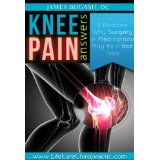
Knee arthritis and steroid injections
Somewhere along the line steroid injections became the knee-jerk (pun intended) reaction for pain anywhere.
Shoulder pain? Shoot it with some steroids. Elbow pain? Wrist pain? Knee pain? Scoot right on up and we’ll stick some corticosteroids directly into the joint. Low back pain? Despite the fact that there is very little evidence to support it, let’s go ahead and inject steroids into the sanctity of the spinal canal and see what happens.
When given orally, most would shudder at the random use of steroids given the risks of bone damage, obesity, diabetes and brain damage. But given that it’s just a local injection it doesn’t affect the rest of the body.
At least, that’s what most people (doctor’s included) think. Then why, in a prior blog article I did several years ago, did researchers find that it didn’t matter whether the injection was given directly into the shoulder or whether it was given in the buttock? Because it does not matter. Steroids, whether given orally, inhaled or injected anywhere, have an effect everywhere else in the body.
Because of this, we need to be darned sure that every use of steroids is going to have a positive effect on whatever condition it is being used for. This definitely includes steroids being used for pain. Which is why I bring you this particular article.
In it, researchers looked at whether the use of a cortisone injection for knee pain 2 weeks prior to a 12 week supervised exercise program helped in the long run or not. All participants had arthritis of the knee on X-ray, clinical signs of localized inflammation in the knee as well as knee pain during walking (score >4 on a scale of 0 to 10).
The participants were evaluated using the Pain subscale of the Knee Injury and Osteoarthritis Outcome Score (KOOS) questionnaire (range, 0-100, where higher scores indicate greater improvement). Half of 100 knee pain patients ended up in the steroid injection group and the other half in the placebo-injection group. Here’s what they found:
- After 14 weeks, those in the steroid group had a change of 13.6 on the KOOS score and those in the placebo group changed by 14.8 points.
Basically, the use of steroids led to a difference of 1.2 points (out of 100). In addition, there were no differences in physical function, markers of inflammation or additional KOOS pain scores.
In other words, there were increased costs and increased risk of systemic damage from the steroids but no actual benefit. Just to thrown a further wrench into the use of steroid injections for knee pain, it is entirely possible that the injection itself may have some benefits by disrupting blood vessels and bringing new nutrients and blood flow to the joint. In other words, the benefits of the steroids may be even less (or worse-creating WORSE outcomes) because the injection portion of both treatments may have therapeutic benefits.
In case this STILL isn’t enough for you, it is very clear that any anti-inflammatory treatment damages the joint surface itself, preventing the cells from healing from future damage. This means that, not only does the use of steroid injections for knee osteoarthritis symptoms not actually help, but you are damaging your knees for the future.
If you are wondering what else you can do to help your knee pain, feel free to check out my Knee Pain eBook on Amazon by clicking here.
